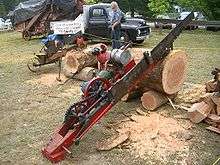Dragsaw

A dragsaw is an early reciprocating saw using a long (for example 1.8 m, 6-foot) steel crosscut saw to buck logs to length. Prior to the popularization of the chainsaw during World War II, the dragsaw was a popular means of taking the hard work out of cutting wood.
According to one hypothesis, evidence for the use of stone-cutting dragsaws may date from the Fourth Dynasty of Egypt, about 4,500 years before its commonly accepted date of invention.[1] Dragsaws were the "grandfather" of chain and reciprocating saw and are known as the first mechanical saws used in the timber industry operation. Powered by a steam-powered winch, they were supposed to be portable, but in reality weight of nearly 400 pounds, made their mobility rather limited. These huge tools were useful the log business, because they were efficient and very resilient. Early dragsaws of the modern era were steam powered and later gasoline powered. Some manufacturers included Multnomah, Vaughn and Wee McGregor.
References
- ↑ Moores, Robert G., Jr. (1991), "Evidence for Use of a Stone-Cutting Drag Saw by the Fourth Dynasty Egyptians", Journal of the American Research Center in Egypt, 28: 139–48 (148), doi:10.2307/40000576